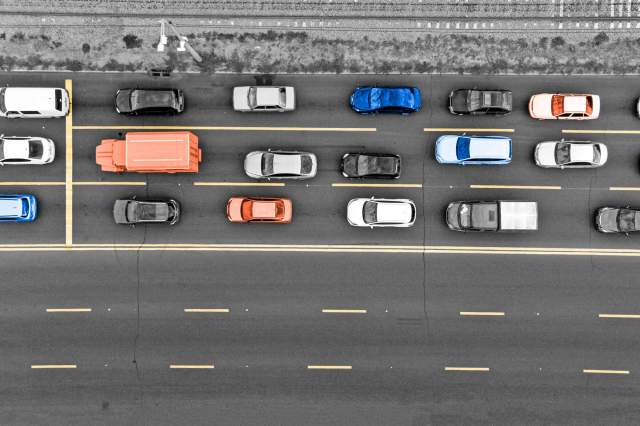
The Average American Lost 51 Hours in Traffic in 2022
According to the traffic analytics firm INRIX, Americans spent, on average, 51 hours stuck in traffic in 2022. That may seem like a lot, but the United Kingdom had it worse: Brits lost 80 hours on average. Americans’ traffic delays also cost an average $546 in fuel costs, INRIX says. All of those numbers are a huge jump from the year before, but that doesn’t mean much, because …

Traffic Dropped During the COVID-19 Pandemic
With many workers required to stay home at the beginning of the COVID-19 pandemic, fewer cars were on the road, and congestion dropped. The Texas A&M Transportation Institute noted that in 2020, January and February were pretty normal — but in March, after COVID lockdowns started to take effect in much of the country, traffic looked more like it did in the early 1990s. By the fall, traffic had started to creep back up to around 2005 levels.
Even after congestion started to ramp back up, however, the effects of the pandemic lingered. According to INRIX, some major American cities, including New York, Boston, and Philadelphia, still saw decreases in 2022 compared to 2019.

Chicago May Have the Worst Traffic in the U.S.
Unlike some cities, Chicago’s traffic is slightly worse than it was before 2020 — and according to INRIX’s annual global rankings, it’s the most congested city in the United States by a significant margin, with the average commuter spending 155 hours in traffic delays in 2022. On a global scale, it’s nearly tied with London, which INRIX analyzed to be the highest-traffic city in the world.
More Interesting Reads

Traffic Really Does Come Out of Nowhere Sometimes
If you drive, chances are you’ve ended up in traffic with no clear cause — there are no accidents or construction, and yet somehow you’re at a total standstill. These are called phantom traffic jams or jamitons, and experts say you can help avoid them by not riding anyone’s bumper.
These jams happen when one driver abruptly slows or brakes, and the next driver slows or stops to avoid a collision. This travels like a wave, usually 100 to 1,000 yards long, even as the drivers at the front of the line return to normal speeds.
The easiest way to prevent phantom traffic jams, according to multiple studies, is to keep about an even distance between the car in front of you and the car behind you — so avoid tailgating, but also keep an eye on your rearview mirror. Giving cars more space to gradually adjust speed won’t completely eliminate phantom jams, but it will make them less likely to occur.

Traffic Lights Used To Be Manually Operated
The first traffic light was gas-powered and installed in London on December 9, 1868, just outside the Houses of Parliament. Automated lights were still several decades away, so the signal had to be manually operated by a police officer 24 hours a day. This first light lasted only a month. While London wouldn’t attempt to have traffic lights again until the city installed automatic ones, other cities adopted manual traffic lights and spent decades staffing them. The first electric light was installed in Cleveland, Ohio, in 1914.

Car Accidents Are More Likely Right After the Daylight Saving Switch
If you’re not a morning person, the days immediately following the switch to daylight saving time — or “spring forward” — might be a struggle, especially that first Monday morning. With so many sleepy drivers on the road, accidents are more likely. The average American’s risk of getting in a car accident rises by around 6% that day, along with an increase in other potentially fatal events such as heart attacks and strokes.

A Traffic Jam in China Lasted More Than a Week
In August 2010, motorists outside Beijing got stuck in a real doozy of a traffic jam, caused by a harrowing conjunction of a construction project and too many cars on an already overburdened freeway. The jam stretched for 60 miles and lasted around 11 days. Some individual cars were stuck on the road for more than five days. Local villagers took advantage of the situation by selling food and water to drivers at a premium, including water bottles marked up to around 10 times their original price. Officials estimated the jam could have lasted a couple of weeks longer, which thankfully did not come to fruition — although major traffic jams continued to be a problem.












